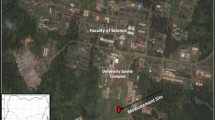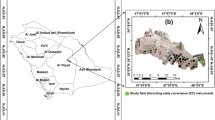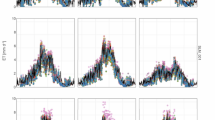Abstract
While low cost eddy covariance (EC) techniques based on the open-path laser analyzers have been widely used, they are not very accurate and are restricted to use in non-rainy days. As an alternative, and relevant to promoting precision agriculture where water availability is proving key, the application of the EC technique based on closed-path QCLAS-EC Analyzer is described, in a study of cabbage farmland evapotranspiration (ET). This study uses the advantages of the closed-path EC method to quantitatively assess the impact of agricultural activities on farmland ET and compared with RZWQM2 (Root Zone Water Quality Model) model. The cumulative ET is shown to have increased by 1.5–3.6 mm over ten-days after planting, and decreased by 3.5–8.1 mm over 10 days, following harvesting. While irrigation contributed to ET, the cumulative ten-day ET increase is between 0.6–2.3 mm which is significantly lower than the effects due to planting and harvesting. The RZWQM2 model was used to quantify the effects of four agricultural practices. Simulation of ET attained R2 and RMSE as 0.79 and 0.013 mm/d, respectively. In addition, the RZWQM2 model successfully simulated groundwater levels, Leaf area index, and crop height (R2 values of 0.71, 0.98 and 0.97, respectively). The RZWQM2 model simulates the effects of planting, harvesting, and irrigation on ET, indicating the same directional changes of magnitude with measured data. The results provide a comprehensive and direct study based on the closed-path EC method and RZWQM2 model to assess the impact of multiple agricultural activities on farmland ET and to improve precision agriculture.






Similar content being viewed by others
References
Allen RG, Smith M, Perrier A, Pereira LS (1994) An update for the definition of reference evapotranspiration. ICID Bulletin 43(2)
Alves I, Cameira MR (2002) Evapotranspiration estimation performance of root zone water quality model. Evaluation and improvement. Agric Water Manag 57:61–73
Aouade G, Ezzahar J, Amenzou N (2016) Combining stable isotopes, Eddy covariance system and meteorological measurements for partitioning evapotranspiration, of winter wheat, into soil evaporation and plant transpiration in a semi-arid region. Agric Water Manag 177:181–192
Baldocchi DD (2003) Assessing the eddy covariance technique for evaluating carbon dioxide exchange rates of ecosystems: past, present and future. Glob Chang Biol 9:479–492
Casa AC, Ovando GG (2016) Variation of reference evapotranspiration in the central region of Argentina between 1941 and 2010. J Hydrol Reg Stud 5(C):66–79
Detto M, Verfaillie J, Anderson F, Xu L, Baldocchi D (2011) Comparing laser-based open- and closed-path gas analyzers to measure methane fluxes using the eddy covariance method. Agric For Meteorol 151(10):1324
Foken T, Göockede M, Mauder M (2004) Post-field data quality control. Handbook of micrometeorology: a guide for surface flux measurement and analysis
Guerschman JP, Dijk AIJ, Mattersdorf G (2009) Scaling of potential evapotranspiration with MODIS data reproduces flux observations and catchment water balance observations across Australia. J Hydrol 369(1):107–119
Ham JM, Heilman JL (2003) Experimental test of density and energy-balance corrections on carbon dioxide flux as measured using open-path eddy covariance. Agron J 95(6)
Hao S-L (2002) Research on adaptability of RZWQM model in North China - a case study of Yucheng integrated Experimental Station of Chinese Academy of Sciences in Shandong Province. Jiangxi Agricultural University
Jones JW, Hoogenboom G, Porter CH, Boote HJ, Batchelor WD, Hunt LA, Wilkens PW, Singh U, Gijsman AJ, Ritchie JT (2003) The DSSAT cropping system model. Eur J Agron 18:235–265
Karbasi M (2018) Forecasting of multi-step ahead reference evapotranspiration using wavelet-Gaussian process regression model. Water Resour Manag 32(3):1035–1052
Khand K, Kjaersgaard J, Hay C (2017) Estimating impacts of agricultural subsurface drainage on evapotranspiration using the Landsat imagery-based METRIC model. Hydrology 4(4)
Kotani A, Hiyama T, Ohta T (2017) Impact of rice cultivation on evapotranspiration in small seasonal wetlands of north-Central Namibia. Hydrol Res Lett 11(2):134–140
Lawrence DM, Thornton PE, Oleson KW (2007) The partitioning of evapotranspiration into transpiration, soil evaporation, and canopy evaporation in a GCM: impacts on land atmosphere interaction. J Hydrometeorol 8(4):862
Lei H, Yang D, Yang H (2015) Simulated impacts of irrigation on evapotranspiration in a strongly exploited region: a case study of the Haihe River basin, China. Hydrol Process 29(12):2704–2719
Luo Y, Traore S, Lyu X (2015) Medium range daily reference evapotranspiration forecasting by using ANN and public weather forecasts. Water Resour Manag 29(10):3863–3876
Ma L, Hoogenboom G, Ahuja LR, Nielsen DC, Ascough JC II (2005) Development and evaluation of the RZWQM-CROPGRO hybrid model for soybean production. Agron J 97:1172–1182
Ma L, Ahuja LR, Nolan BT (2012) Root zone water quality model (RZWQM2): model use, calibration, and validation. Trans ASABE 55(4):1425–1446
Machado S, Petrie S, Rhinhart K, Ramig RE (2008) Tillage effects on water use and grain yield of winter wheat and green pea in rotation. Agron J 100(1)
Morell FJ, Lampurlanés J, Álvaro-Fuentes J (2011) Yield and water use efficiency of barley in a semiarid Mediterranean agroecosystem: Long-term effects of tillage and N fertilization. Soil Till Res 117(6):76–84
Ouyang Y, Feng G, Leininger TD (2018) Pond and irrigation model (PIM): a tool for simultaneously evaluating pond water availability and crop irrigation demand. Water Resour Manag 32(9):2969–2983
Rudnick DR, Irmak S, Djaman K (2017) Impact of irrigation and nitrogen fertilizer rate on soil water trends and maize evapotranspiration during the vegetative and reproductive periods. Agric Water Manag 191:77–84
Shuttleworth WJ, Wallace JS (1985) Evaporation from sparse crops-an energy combination theory. Quarterly J Royal Meteorol Soc 111(469)
Sun G, Alstad K, Chen J (2011) A general predictive model for estimating monthly ecosystem evapotranspiration. Ecohydrology 4(2):245–255
Wang Z, Qi Z, Xue L (2016) RZWQM2 simulated management practices to mitigate climate change impacts on nitrogen losses and corn production. Environ Model Softw 84(C):99–111
Yang Y, Anderson M, Gao F (2017) Impact of tile drainage on evapotranspiration in South Dakota, USA, based on high spatiotemporal resolution evapotranspiration time series from a multisatellite data fusion system. IEEE J. Selec. Top. Appl. Earth Obs. Remote Sens pp (99):1-15
Zhang L, Dawes WR, Walker GR (2001) Response of mean annual evapotranspiration to vegetation changes at catchment scale. Water Resour Res 37(3):701–708
Zhang Y, Zheng H, Chiew FHS (2016) Evaluating regional and global hydrological models against Streamflow and evapotranspiration measurements. J Hydrometeorol 17(3)
Acknowledgements
This research was financially supported by National Natural Science Foundation of China (4151101201) and Ministry of Science and Technology (2016YFC0400709).
Author information
Authors and Affiliations
Corresponding author
Additional information
Publisher’s Note
Springer Nature remains neutral with regard to jurisdictional claims in published maps and institutional affiliations.
Keypoints
1) Using a closed-path eddy covariance device monitor, all-weather high resolution farmland ET observations is achieved.
2) The effects of different agricultural activities on farmland ET based on high resolution ET data is achieved.
3) Comprehensive comparison of the impact of multiple agricultural activities on ET with measured data and RZWQM2 model is achieved.
Rights and permissions
About this article
Cite this article
Chen, H., Huang, J.J., Wang, K. et al. Quantitative Assessment of Agricultural Practices on Farmland Evapotranspiration Using EddyCovariance Method and Numerical Modelling. Water Resour Manage 34, 515–527 (2020). https://doi.org/10.1007/s11269-019-02448-9
Received:
Accepted:
Published:
Issue Date:
DOI: https://doi.org/10.1007/s11269-019-02448-9




